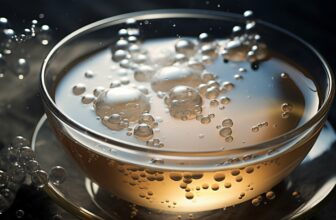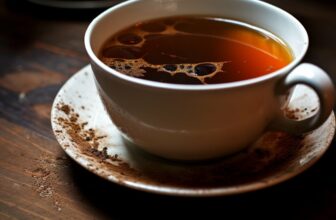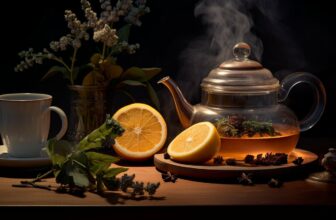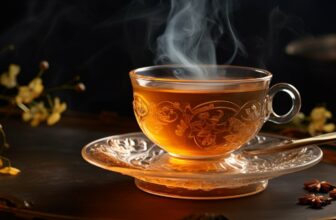
Oolong milk tea is a delightful and unique beverage that combines the flavors of oolong tea and creamy milk. If you’re curious about what oolong milk tea tastes like, you’re in for a treat. The flavor profile of this tea is a wonderful blend of earthy, floral, and creamy notes that create a harmonious and satisfying drinking experience.
The taste of oolong milk tea is influenced by the characteristics of oolong tea itself. Oolong tea falls between black and green tea in terms of oxidation, giving it a distinct flavor that is neither too bold nor too light. The level of oxidation and roasting of the tea leaves further adds complexity to its taste.
Light oolong tea, with minimal oxidation, has a fresh and earthy taste reminiscent of green tea. It offers delicate floral and vegetal notes that are enhanced by the creamy texture of the milk. Medium oolong tea, with a moderate level of oxidation, presents warmer flavors of honey and toasted grains, which pair beautifully with the milk. Dark oolong tea, with higher oxidation, boasts a robust and rich aroma that is often compared to the fragrance of coffee.
The combination of these flavor profiles creates a diverse and complex drink that is both refreshing and comforting. It’s a beverage that can be enjoyed hot or cold, making it suitable for any weather or mood.
Key Takeaways:
- Oolong milk tea is a flavorful blend of oolong tea and milk.
- Light oolong tea has a fresh and earthy taste, similar to green tea.
- Medium oolong tea offers warmer flavors of honey and toasted grains.
- Dark oolong tea has a strong and rich aroma, often compared to coffee.
- Oolong milk tea provides a diverse and complex drinking experience.
What is Oolong Tea?
Oolong tea is a unique and flavorful beverage that sits between black and green tea in terms of oxidation. It is produced through an oxidation process that ranges from 8-80%, giving it a distinct flavor profile. The tea leaves are often rolled or twisted, further enhancing the characteristics of the final product. Oolong tea can have a wide range of flavors, from light and floral to dark and chocolate-like.
“Oolong tea is a versatile drink that offers a complex and diverse taste experience.”
Lighter oolong teas have a fresh and earthy taste similar to green tea, while medium oolongs have warmer notes of honey and toasted grains. Dark oolongs, on the other hand, have a robust and rich aroma often compared to coffee. The different levels of oxidation and the rolling technique contribute to the complexity and depth of flavor in oolong tea.
What is Oolong Tea?
| Category | Flavor Profile |
|---|---|
| Light Oolong | Fresh, earthy, similar to green tea |
| Medium Oolong | Warmer notes of honey and toasted grains |
| Dark Oolong | Strong and rich aroma, often compared to coffee |
Oolong tea is a versatile drink that offers a complex and diverse taste experience. Whether you prefer lighter, floral teas or stronger, more robust flavors, there is an oolong tea to suit your palate. The unique combination of oxidation, rolling technique, and tea leaf varieties contribute to the wide range of flavors found in oolong tea. So, if you’re looking to explore the world of tea beyond black and green, give oolong tea a try and discover a whole new level of taste.
The Story of Oolong Tea
Oolong tea, a beloved beverage with a rich history, has its origins rooted in China and Taiwan. It is no surprise that these regions are the primary producers and consumers of this unique tea. Oolong tea is said to have been discovered by accident, when tea leaves were left to oxidize. This accidental process gave birth to the fascinating flavors that oolong tea is known for today.
The mountains of China and Taiwan provide the ideal conditions for growing oolong tea. These regions offer varying elevations and microclimates, which contribute to the distinct characteristics of oolong tea from different areas. Each region has its own unique flavor profile, ranging from floral and delicate to robust and earthy.
While China and Taiwan are the main oolong tea producers, other countries have also embraced this tea variety. India, Japan, and New Zealand are among the countries that have started cultivating oolong tea, offering their own interpretations of this beloved beverage. The globalization of oolong tea has allowed enthusiasts around the world to discover and appreciate the diverse flavors and aromas it brings.
Regional Characteristics of Oolong Tea
| Region | Characteristics |
|---|---|
| China (Fujian) | Floral and light-bodied with hints of orchid and peach |
| Taiwan (Alishan) | Smooth and creamy with a unique milk oolong flavor |
| Taiwan (Dong Ding) | Roasted and nutty with a caramel-like sweetness |
| India (Darjeeling) | Delicate and fruity with muscatel notes |
From the misty mountains of China to the sprawling tea estates of India, oolong tea has captured the hearts and palates of tea enthusiasts worldwide. The story of oolong tea continues to unfold as new regions experiment with their own unique flavors and techniques, expanding the ever-growing world of this fascinating drink.
How to Differentiate Oolong?
Oolong tea is a versatile beverage that comes in different types and flavors, making it a delight for tea enthusiasts. The distinct characteristics of oolong tea can be attributed to the level of oxidation and roasting, as well as the specific processing methods used. By understanding these factors, you can differentiate between the various types of oolong tea and explore their unique flavors.
Oolong Tea Flavors
Oolong tea offers a wide range of flavors, each with its own distinct profile. The flavor of oolong tea can range from light and floral to dark and robust. Here are some common types of oolong tea and their flavor profiles:
- Light Oolong Tea: Light oolong tea is similar to green tea, with a fresh and vegetal taste. It has a delicate aroma and subtle flavors.
- Medium Oolong Tea: Medium oolong tea has a richer flavor profile, with notes of honey, toasted grains, and fruits. It offers a balanced combination of floral and earthy flavors.
- Dark Oolong Tea: Dark oolong tea has a bold and robust flavor, often compared to coffee. It has a strong aroma and a complex taste with hints of caramel, chocolate, and roasted nuts.
These are just a few examples of the different flavors you can find in oolong tea. The flavor profiles can vary depending on the specific type of oolong tea and the region where it is grown.
Oolong Tea Processing Methods
The processing methods used for oolong tea can also influence its flavor. Here are some common processing techniques:
- Oxidation Level: The level of oxidation determines the overall flavor of oolong tea. Lightly oxidized oolong tea will have a more green tea-like flavor, while heavily oxidized oolong tea will have a darker and more robust taste.
- Roasting: Roasting is another important step in oolong tea processing. It can enhance the flavors and aromas of the tea, adding depth and complexity. Light roasting will result in a milder flavor, while heavy roasting will produce a stronger and more roasted taste.
- Rolling: Rolling the tea leaves during processing can also affect the flavor of oolong tea. It helps to release the natural oils and enzymes, contributing to the overall taste and aroma.
By understanding the different types of oolong tea flavors and the processing methods used, you can differentiate between various oolong teas and choose the one with the flavor profile that suits your taste preferences.
| Type of Oolong | Flavor Profile |
|---|---|
| Light Oolong | Fresh, vegetal, delicate |
| Medium Oolong | Honey, toasted grains, fruity |
| Dark Oolong | Robust, coffee-like, caramel, chocolate, roasted nuts |
Get Oolong Tea Right
If you want to fully enjoy the complex flavors of oolong tea, it’s essential to know how to prepare it correctly. Brewing oolong tea is a delicate process that requires attention to detail. Here are the steps to steeping the perfect cup:
- Start with fresh, filtered water. Oolong tea is best brewed with water at a temperature of 180-200°F (82-93°C). Boil the water and then let it cool for a few minutes to reach the desired temperature.
- Measure the tea leaves. The general rule of thumb is to use 1 teaspoon of tea leaves for every 8 ounces of water.
- Place the tea leaves in a teapot or infuser. Pour the hot water over the leaves and cover the teapot or infuser to let the tea steep.
- The steeping time for oolong tea can vary depending on the specific type and your personal preference. Generally, steeping for 1-3 minutes is recommended. Longer steeping times will result in a stronger flavor.
- Once the tea has finished steeping, remove the leaves or strain the tea to separate the leaves from the liquid. Enjoy your freshly brewed cup of oolong tea!
Remember that oolong tea can be steeped multiple times, so you can savor its flavors over several infusions. Each steeping will reveal new depths of flavor and complexity. Experiment with different steeping times and leaf-to-water ratios to find your perfect cup of oolong tea.
Enhancing Your Oolong Tea Experience
If you want to elevate your oolong tea experience, consider using a gongfu brewing method. Gongfu brewing involves using smaller teapots and shorter steeping times to extract the full flavors of the tea. This method allows you to fully appreciate the nuances of each infusion. It’s a more involved process but can be highly rewarding for tea enthusiasts.
Additionally, you can experiment with different varieties of oolong tea. Each type of oolong has its own unique flavor profile, so exploring different options can be a delightful adventure. From light and floral to dark and robust, there is a world of oolong teas to discover.
So, next time you brew a cup of oolong tea, take the time to prepare it properly and explore the vast array of flavors that this fascinating tea has to offer.
Oolong Milk Tea Recipe
Indulge in the rich and creamy flavors of oolong milk tea with this simple and delightful recipe. Combining the unique taste of oolong tea with the smoothness of milk, this beverage is a perfect treat for any tea lover. Here’s how you can make your own oolong milk tea:
- Boil water and steep oolong tea leaves for five minutes to extract the flavors.
- Allow the tea to cool while preparing the brown sugar syrup.
- In a separate pot, mix sugar and water to create a brown sugar syrup.
- Combine the cooled tea, brown sugar syrup, and milk of your choice.
- Variations of this recipe include using jasmine tea, rose tea, or chamomile tea leaves for additional flavor.
- You can also use different types of milk, such as almond, oatmeal, soy, or whole milk, to suit your preferences.
- Stir well to ensure all the ingredients are thoroughly mixed.
- Serve the oolong milk tea over ice for a refreshing drink, or enjoy it warm on a cozy afternoon.
Why Oolong Milk Tea?
“Oolong milk tea is a delightful fusion of the earthy and complex flavors of oolong tea with the creamy and comforting taste of milk. The combination creates a harmonious blend that tantalizes the taste buds and offers a unique sensory experience.”
Whether you’re a fan of traditional tea or looking to try something new, oolong milk tea is a must-try. Its balance of flavors and versatility make it a favorite beverage for many tea enthusiasts. So why not treat yourself to a cup of oolong milk tea and savor the delightful combination of tea and milk?
Oolong Tea with Chia Seeds
One intriguing variation of oolong milk tea is the addition of chia seeds. Chia seeds can be a delightful and textural enhancement to the traditional beverage, reminiscent of the popular boba tea. To create this unique twist, simply boil the chia seeds and add them to the bottom of the glass before pouring the oolong milk tea. This simple addition adds an enjoyable and satisfying element to the drink.
Chia seeds are renowned for their numerous health benefits, making them an excellent addition to oolong milk tea. They are rich in omega-3 fatty acids, antioxidants, and fiber, which can help support a healthy diet. Furthermore, chia seeds have the ability to absorb liquid and form a gel-like consistency, adding an interesting texture to the drink. This combination of flavors and textures makes oolong tea with chia seeds a truly unique and enjoyable beverage.
While traditional oolong milk tea is typically made with black tea leaves and milk, adding chia seeds opens up a world of possibilities for experimentation. You can customize your oolong milk tea by adding different flavors such as jasmine, rose, or chamomile tea leaves. Additionally, you can try using various types of milk, such as almond, oatmeal, soy, or whole milk, to create your preferred taste and texture. The versatility of oolong tea with chia seeds allows you to tailor the beverage to your personal preferences and create a truly unique and delicious drink.
To summarize, adding chia seeds to oolong milk tea is a creative and healthy way to enjoy this delightful beverage. The combination of flavors and textures creates a unique and satisfying drinking experience. Whether you prefer the traditional black tea base or want to experiment with different flavors and types of milk, oolong tea with chia seeds offers endless possibilities for customization. Give it a try and discover the deliciousness of this refreshing twist on a classic favorite.
What is Oolong Milk Tea Taste Like? – The Flavor of Milk Oolong Tea
Milk oolong tea is a unique variety of oolong tea that offers a distinct flavor profile. It is known for its buttery scent and creamy aftertaste, which sets it apart from other types of oolong tea. The aroma of milk oolong is derived from the specific tea bush called Jin Xuan, which undergoes a special fermentation and roasting process. This process gives the tea its unique flavor characteristics that enthusiasts love.
When brewed, milk oolong tea exhibits a smooth and velvety texture. It has a delicate and sweet taste with subtle hints of natural milkiness. It is important to note that high-quality milk oolong tea should have a subtle milky scent, not an overpowering artificial flavoring. The flavors and aromas of milk oolong are more developed and rich when grown at higher elevations. Each sip of milk oolong tea provides a delightful experience for the senses.
The flavor of milk oolong tea can be further enhanced by adding milk or other ingredients such as honey or sugar. These additions complement the natural creamy notes of the tea, creating a well-balanced and flavorful beverage. Whether enjoyed hot or cold, milk oolong tea is an indulgent treat for tea lovers seeking a unique twist on traditional oolong.
Table: Milk Oolong Tea Flavor Profile
| Flavor | Description |
|---|---|
| Buttery | Milk oolong tea has a buttery scent and creamy aftertaste. |
| Delicate | The taste of milk oolong tea is delicate and sweet. |
| Subtle milkiness | Milk oolong tea has a natural milkiness that is not overpowering. |
| Smooth and velvety | The texture of milk oolong tea is smooth and velvety. |
Characteristics of High-Quality Oolong
In order to truly savor the rich flavors and aromas of oolong tea, it’s important to choose high-quality varieties. Here are some characteristics to look for when identifying high-quality oolong tea:
- Whole Leaves: High-quality oolong tea is made from whole leaves that are rolled into tight pellets. These pellets gradually unfurl when steeped, releasing their unique flavors and aromas.
- No Impurities: When examining the tea leaves, there should be no small particles, dust, twigs, or other impurities present. This ensures a clean and pure tea experience.
- Natural Aroma: High-quality oolong tea has a natural and pleasant aroma, derived from the specific processing methods and terroir of the tea leaves. The aroma should not be overpowering or artificial.
- Green Color: The color of the tea leaves should be vibrant green with noticeable highlights. This indicates that the leaves have been properly processed and retain their freshness.
By selecting oolong tea that exhibits these characteristics, you can ensure that you are enjoying a high-quality and authentic tea experience.
| Characteristics | High-Quality Oolong Tea |
|---|---|
| Leaf Appearance | Tightly rolled whole leaves |
| Impurities | No small particles, dust, or twigs |
| Aroma | Natural and pleasant |
| Color | Vibrant green with highlights |
Choosing high-quality oolong tea guarantees a more enjoyable and authentic tea-drinking experience. When brewed properly, these teas will highlight the unique flavors and aromas that make oolong tea so special.
The Benefits of Oolong Milk Tea
Oolong milk tea offers a multitude of health benefits. As a rich source of antioxidants, it helps to combat free radicals in the body and strengthen the immune system. The unique combination of oolong tea and milk provides a soothing and comforting beverage that can aid in relaxation and stress reduction.
One of the key benefits of oolong milk tea is its potential to support weight loss. Oolong tea has been shown to boost metabolism and increase fat oxidation, making it a popular choice for those looking to shed a few pounds. Additionally, the combination of oolong tea and milk can help to curb appetite and reduce cravings.
Drinking oolong milk tea may also have positive effects on cardiovascular health. Research has shown that regular consumption of oolong tea can help to lower blood pressure and reduce the risk of heart disease. The antioxidants found in oolong tea can improve the health of blood vessels, promoting better circulation and reducing the risk of strokes and heart attacks.
Furthermore, oolong milk tea has been associated with various other benefits such as improved skin appearance, enhanced brain function, and improved digestion. The natural compounds found in oolong tea can help to improve skin elasticity and reduce the signs of aging. The caffeine and other stimulants in oolong tea can improve mental alertness and cognitive function. Lastly, oolong tea has been used for centuries to aid digestion and relieve stomach discomfort.
The Health Benefits of Oolong Milk Tea:
- Rich in antioxidants that boost the immune system
- Potential to aid in weight loss and reduce cravings
- Supports cardiovascular health and reduces the risk of heart disease
- Improves skin appearance and reduces signs of aging
- Enhances brain function and mental alertness
- Helps with digestion and relieves stomach discomfort
“Oolong milk tea offers a soothing and comforting beverage that provides a host of health benefits.”
In conclusion, oolong milk tea is not only a delicious and refreshing beverage, but it also offers numerous health benefits. From boosting the immune system to promoting weight loss and supporting cardiovascular health, oolong milk tea is a beverage worth incorporating into your daily routine. So sit back, relax, and enjoy a cup of oolong milk tea knowing that you are not only indulging in a flavorful drink but also nourishing your body.
Conclusion
In conclusion, oolong milk tea is a delightful and versatile beverage that offers a diverse range of flavors and aromas. Whether you prefer the fresh and earthy taste of light oolong tea or the rich and robust aroma of dark oolong tea, there is a flavor profile to suit every palate.
By brewing oolong tea properly and following recipes, you can enhance the taste and create a truly enjoyable oolong milk tea experience. Whether you choose to enjoy it plain or with added ingredients such as milk or chia seeds, oolong milk tea is sure to provide a satisfying and delicious drink.
Not only does oolong milk tea offer a unique and flavorful taste, but it also provides numerous health benefits. From aiding in weight loss and boosting metabolism to promoting cardiovascular health and improving skin appearance, oolong milk tea can be a great addition to a healthy lifestyle.
So why not give oolong milk tea a try? Explore the different flavors, experiment with brewing methods, and discover the taste that suits you best. Whether you’re a tea connoisseur or simply someone looking for a new and exciting beverage, oolong milk tea is sure to satisfy your taste buds and leave you wanting more.
FAQ
What is oolong milk tea taste like?
Oolong milk tea has a diverse and complex flavor profile. It can range from fresh and earthy, similar to green tea, to warm notes of honey and toasted grains in medium oolong tea. Dark oolong tea has a strong and rich aroma, often compared to coffee.
What is oolong tea?
Oolong tea is a unique beverage that falls between black and green tea in terms of oxidation. The flavor of oolong tea can vary depending on the level of oxidation and roasting. It can have a wide range of flavors, from light and floral to dark and chocolate-like.
Where does oolong tea come from?
Oolong tea has its origins in China and Taiwan, where it is consumed more than any other country. It is also grown in other countries such as India, Japan, and New Zealand.
How to differentiate oolong?
Oolong tea can have different flavors depending on the level of oxidation and roasting. Light oolong tea is similar to green tea, while medium oolong tea has warmer notes of honey and toasted grains. Dark oolong tea has a strong and rich aroma, often compared to coffee. There are also different processing methods that can affect the flavor of oolong tea.
How to prepare oolong tea?
The brewing process for oolong tea can vary, but generally, it is recommended to use hot water at a temperature of 180-200°F and steep the tea for 1-3 minutes. Oolong tea can be steeped multiple times, with each steeping revealing new flavors and aromas.
How to make oolong milk tea?
One popular recipe involves boiling water and steeping oolong tea leaves for five minutes. After steeping, the tea is allowed to cool. In a separate pot, a brown sugar syrup is prepared by mixing sugar and water. The tea, syrup, and milk are then combined to create the oolong milk tea.
Can I add chia seeds to oolong milk tea?
Yes, adding chia seeds to oolong milk tea can create a unique twist. Chia seeds can be boiled and added to the bottom of the glass before pouring the oolong milk tea. This adds a fun and textural element to the drink, similar to boba pearls.
What does milk oolong tea taste like?
Milk oolong tea has a unique flavor profile characterized by its buttery scent and creamy aftertaste. The aroma of milk oolong is derived from the specific tea bush called Jin Xuan, which undergoes a special fermentation and roasting process.
How can I identify high-quality oolong tea?
High-quality oolong tea is characterized by whole leaves rolled into hard round pellets that open when wet. It should be free of small particles, dust, twigs, and other impurities. Artificial flavorings should not be present in high-quality oolong tea.
What are the benefits of oolong milk tea?
Oolong milk tea offers several health benefits. It can aid in weight loss, boost metabolism, and strengthen the immune system. Oolong milk tea also has positive effects on cardiovascular health, skin appearance, brain function, digestion, mood, and fatigue.












